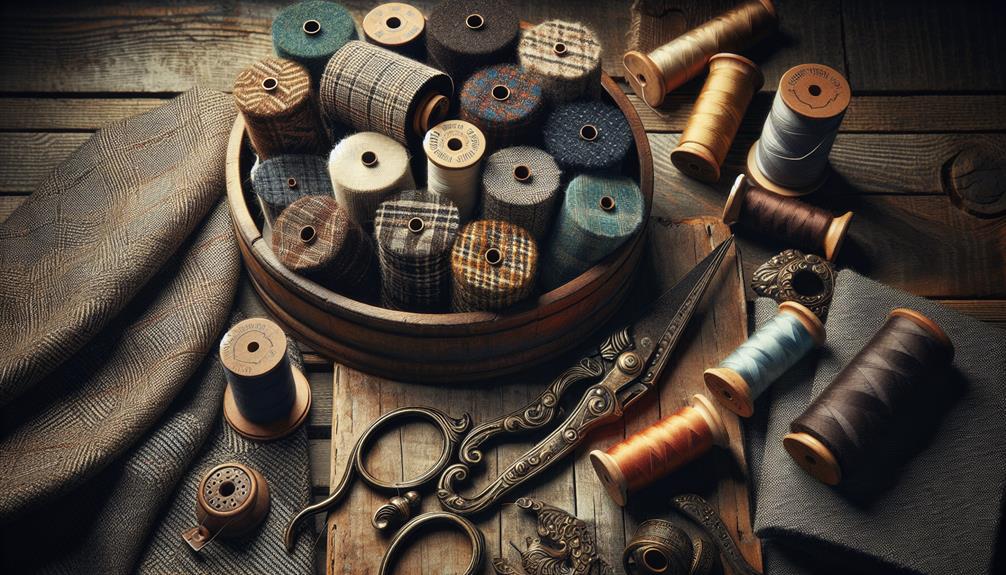I've always wondered why tweed remains so popular, despite the countless new fabrics and trends that emerge every season. It's not just another material; it's a piece of history that's woven into the very fabric of fashion. Originating from the Scottish Isles, tweed was first used by farmers to brave the chilly, wet weather. Over time, it's become a staple in both high fashion and everyday wardrobes, celebrated for its durability and timeless style. But there's more to tweed's story that keeps it in the limelight. Why do you think tweed has maintained its charm and utility over the years?
Table of Contents
Key Takeaways
- Tweed's timeless charm and association with luxury and sophistication enhance its popularity.
- Its durability and versatility make it suitable for various styles and occasions.
- Tweed's adoption by influential figures and its portrayal in media boost its desirability.
- The fabric's alignment with sustainable and eco-friendly fashion trends attracts modern consumers.
- Innovations in tweed production, such as water resistance and comfort stretch fibers, keep it contemporary.
Historical Roots of Tweed
Tweed's journey began centuries ago on the Scottish Isles, where locals crafted it to battle the harsh weather. Its origins are deeply rooted in necessity, but it wasn't long before the fabric transcended its practical beginnings. As I explored further, I discovered that its unique appeal caught the attention of the aristocracy, further cementing its place in fashion history.
The aristocratic associations began when members of the British elite started sporting tweed for their outdoor pursuits. Hunting, shooting, and fishing in the rugged landscapes required attire that wasn't only functional but also stylish. Tweed fit the bill perfectly. It's fascinating to think that what started as a humble fabric worn by farmers and fishermen evolved into a symbol of status and taste.
This evolution speaks volumes about tweed's versatility and enduring appeal. It's not just about the fabric's ability to withstand the elements; it's also about its timeless charm that appealed to the upper echelons of society. The journey from practicality to prestige highlights how tweed has woven its way through the fabric of fashion, maintaining relevance across centuries and social classes. As I investigate tweed's story, it's clear why it remains a beloved choice to this day.
Tweed's Unique Production Process
Now, let's talk about how tweed is made, which is pretty fascinating.
First, they pick the best natural materials, which really makes a difference in the quality.
Then, they use time-honored weaving techniques that have been passed down through generations.
Heritage Weaving Techniques
The unique production process of tweed involves age-old weaving techniques passed down through generations. I've always been fascinated by how these methods not only showcase craftsmanship appreciation but also adapt globally, keeping the tradition alive yet vibrant.
Here's a quick look at some key steps in the heritage weaving process:
| Step | Description | Significance |
|---|---|---|
| Warping | Aligning yarns for tension and order | Prepares the loom for weaving |
| Weft Insertion | Horizontal yarn weaving | Builds fabric texture and pattern |
| Beating | Compressing weft into place | Secures tight, durable weave |
| Finishing | Washing and pressing the fabric | Enhances texture and color |
Understanding these steps helps you appreciate the effort and artistry behind every piece of tweed fabric. It's truly a blend of history and contemporary fashion.
Raw Material Selection
After exploring the traditional weaving techniques, let's look at how the choice of raw materials plays a key role in tweed production. Selecting the right fibers is essential not just for texture but also for color and durability. Here's what makes the cut:
- Wool: The backbone of tweed, providing warmth and water resistance.
- Fiber sourcing: Local sourcing guarantees quality and supports local economies.
- Natural dyes: These contribute to the latest color trends, giving tweed its vibrant hues.
- Cashmere and silk blends: For that extra softness and luxury appeal.
Understanding these choices helps us appreciate why tweed remains a staple in fashion. It's all about combining tradition with the latest trends.
Durability and Longevity
Tweed's resilience makes it a top choice for anyone looking for long-lasting wear. It's not just about the style; this fabric can really take a beating and still look great. What makes it so durable? Well, it's all in the tight weave and the natural fibers. These materials come together to create a durable textile that resists wear and tear way better than most.
Beyond just lasting a long time, tweed's color variations are a huge plus. You're not stuck with one look. The fabric's unique mix of colors can hide small blemishes and stains that would ruin other materials. This means your tweed jacket or trousers keep looking fresh, even if you're a bit clumsy with your morning coffee.
Now, let's talk maintenance tips because keeping tweed excellent is easier than you might think. Regular brushing and airing out are enough for most of the year. When it needs more than that, dry cleaning is the way to go. Avoid washing it in water if you can; this can affect the texture and fit. Just a bit of care, and your tweed will stay classy and sturdy for years.
Versatility Across Seasons
Tweed isn't just for winter; it's really versatile across all seasons.
You can layer it up when it's chilly or wear it light when things warm up, thanks to its insulating yet breathable nature.
Plus, it always looks fashionable, whether it's spring or fall.
Layering for Weather Changes
As seasons shift, layering with tweed guarantees comfort and style year-round. It's an absolute game changer when you're trying to stay on top of color trends and style adaptations. Here's why it works so well:
- Adaptability: Tweed jackets can be thrown over a light shirt in spring or layered with a heavy sweater in winter.
- Timelessness: The fabric's rich texture and variety of colors make it easy to match with any season's palette.
- Style Flexibility: Whether you're dressing up for a fall event or keeping it casual in the cool early days of spring, tweed fits right in.
- Personal Touch: Customize with different cuts and weights to express your unique style all year.
Breathable Yet Insulating Properties
Besides its style flexibility, tweed's breathable yet insulating properties make it ideal for any season. I've found that its unique ability to regulate temperature keeps me comfortable whether it's chilly or somewhat mild outside.
Tweed's moisture-wicking capabilities mean that even if I'm caught in a bit of drizzle or I'm sweating a bit, I don't end up feeling clammy or uncomfortable. This fabric really excels in thermal regulation, maintaining a balanced warmth that's not too overpowering. It's like wearing your own personal climate control system.
I think that's why tweed remains a top choice for anyone looking for versatility in their wardrobe. It adapts so well to various weather conditions, making it incredibly practical.
Fashionable Year-Round Appeal
I've noticed that tweed holds up brilliantly across all four seasons, making it a smart pick for any fashion-savvy individual. Its versatility isn't just about staying warm or cool; it's also about looking effortlessly stylish year-round. Here's why:
- Spring Freshness: Lighter tweed blends align perfectly with spring's color trends, adding a textured yet breezy look.
- Summer Sophistication: A tweed waistcoat can be a standout piece at summer gatherings, meshing well with seasonal style adaptations.
- Autumn Richness: The classic tweed jacket complements autumn's earthy tones, keeping you cozy as temperatures dip.
- Winter Elegance: Layered tweed offers robust insulation while enhancing winter whites and bold colors, proving its cold-weather prowess.
Tweed's adaptability makes it a year-round favorite!
Iconic Fashion Statements
Tweed's resurgence as a fashion staple is truly an iconic statement in today's style landscape. It's not just about warmth and durability anymore; tweed has been popping up everywhere, from high fashion runways to street style stars. I've seen firsthand how designers have innovated with this material, making it sleek, stylish, and utterly contemporary.
One key driver behind tweed's modern popularity has to be celebrity endorsements. When you see A-listers rocking tweed in ways that scream coolness, you can't help but want to emulate that look. It's not just about traditional blazers or coats anymore, either. Celebrities are stepping out in tweed dresses, jumpsuits, and even accessories, which shows just how versatile tweed has become.
Moreover, runway trends have greatly amplified this appeal. Every fashion week, it seems like there's more tweed on the catwalks, each collection reinterpreting it in fresh ways. Designers are playing with colors, patterns, and cuts, pushing the boundaries of what tweed can be. This constant reinvention keeps it exciting and relevant, ensuring that tweed remains a key player in the fashion game. It's clear that tweed isn't going anywhere soon, with its deep roots now firmly intertwined with cutting-edge fashion.
Royal Endorsements and Influence
While celebrities have pushed tweed into the spotlight, it's the royal family's embrace of this fabric that has solidified its status as a timeless classic. You see, when the royals wear something, it's not just a fashion statement; it's a signal to the world that this is a look to keep an eye on. And tweed? Well, it's had its fair share of royal outings.
Here are a few reasons why royal endorsements are so pivotal for tweed:
- Visibility: Every time a royal steps out in tweed, it's like a free ad campaign broadcast worldwide. This exposure can't be surpassed.
- Association with Quality: The royal family is synonymous with luxury and quality. If they're wearing tweed, it must be high-caliber, right?
- Influence on Designers: Designers watch what royals wear closely. A nod from the palace can inspire a whole season's worth of collections.
- Shaping Trends: Beyond just pop culture trends, royal choices shape what's chic on a global scale.
This blend of celebrity influence and royal approval really cements tweed's place in both high-fashion and everyday closets. As someone who follows these trends, I've seen firsthand how powerful this endorsement can be. It's about more than just clothes; it's about a legacy of style that transcends generations.
Cultural Significance in Literature
When you think about tweed in literature, Sherlock Holmes probably pops right into your mind. His iconic deerstalker hat and tweed cape coat are almost as famous as his detective skills.
Plus, many British novels set in the countryside use tweed to paint the perfect picture of rural life.
Sherlock Holmes' Iconic Style
Sherlock Holmes' iconic tweed attire has become a timeless symbol in literature, instantly evoking the image of the astute detective. His outfit isn't just significant; it's a vital part of his detective costume, shaping how we picture sleuths even today.
Here's why Holmes' tweed look is more than just fabric:
- Distinct Identity: The tweed suit sets Holmes apart, marking him as both intellectual and approachable.
- Functionality: It's practical for the unpredictable English weather, meshing style with necessity.
- Holmes Influence: Tweed has become synonymous with detective work thanks to him.
- Timelessness: Despite the years, this style remains in vogue, proving the lasting impact of Holmes on fashion and culture.
British Countryside Literary Settings
Reflecting on Holmes' iconic tweed, it's clear that the British countryside itself has had a profound influence on the settings of many beloved literary works. The moors in "Wuthering Heights" and the rolling hills in "Far from the Madding Crowd" serve as more than just backdrops; they're narrative inspiration that infuses the stories with gothic atmospheres and emotional depth.
| Author | Work |
|---|---|
| Emily Brontë | Wuthering Heights |
| Thomas Hardy | Far from the Madding Crowd |
| Arthur Conan Doyle | The Hound of the Baskervilles |
| Daphne du Maurier | Rebecca |
These settings evoke a sense of isolation or drama, shaping the characters and their journeys, making the countryside an essential character in its own right.
Modern Tweed Innovations
Tweed has evolved greatly, incorporating advanced technologies that enhance both its functionality and style. As someone who's always curious about how classic materials can be made even better, I'm fascinated by the innovations in tweed technology. The fabric isn't just for old-school jackets anymore. It's breaking new ground, and here's how:
- Water-Resistant Finishes: New treatments make tweed water-resistant, allowing it to be more versatile in different weather conditions. This means you can rock your tweed coat even on rainy days without worry.
- Stretch Fibers Integration: By weaving stretchable fibers into tweed, manufacturers have made it more comfortable. This adjustment means tweed can now be used in more active and casual wear, not just formal outfits.
- Eco-Friendly Dyes: With a push towards sustainability, the latest color experimentation involves using natural, eco-friendly dyes. This not only reduces environmental impact but also produces unique, vibrant hues that stand out.
- Temperature Regulation: Advanced weaving techniques and materials help tweed maintain a comfortable temperature, keeping you cool in summer and warm in winter.
These tweaks are all about making tweed fit our modern lifestyle while not ditching its classic charm. It's not just a fabric; it's a fusion of tradition and innovation.
Tweed in Contemporary Media
I've noticed that tweed is making a big comeback in movies and TV shows, where it adds a touch of classic style to modern characters. This resurgence isn't just a tribute to nostalgia; it's a confirmation of tweed's timeless appeal and versatility. The texture and depth it brings to the screen are unmatched, making tweed costumes a favorite among costume designers aiming to convey authenticity and sophistication.
Moreover, the influence of celebrity endorsements can't be overstated. When a well-known actor dons tweed on the red carpet or in a character's wardrobe, it sends a signal that tweed isn't only fashionable but also desirable in today's culture. This celebrity pull helps to keep tweed relevant in the public eye, ensuring its place in contemporary fashion trends.
What fascinates me is how tweed has evolved from its traditional roots to become a symbol of chic urbanity. Its presence in media has shifted from stereotypical country attire to an emblem of high fashion and urban cool, often seen in the latest hit series or films. This adaptability is what keeps tweed not just surviving but thriving in the fast-paced world of fashion.
Environmental Benefits and Sustainability
Many individuals may not recognize that producing tweed is actually quite eco-friendly, utilizing natural fibers and low-impact processes. It's simple to delve into why this fabric can be so sustainable, but let's explore why it's such a green choice.
Here's a brief overview to demonstrate just how environmentally friendly tweed is:
- Natural Fibers: Tweed is primarily crafted from wool, a natural, renewable resource. Sheep regrow their fleece annually, making wool a sustainably sourced material without depleting natural resources.
- Low-Impact Manufacturing: The process of weaving tweed often consumes less energy compared to synthetic fabrics. Traditional looms, frequently still powered by artisans' physical efforts, contribute to lower carbon emissions.
- Biodegradable Attributes: Unlike synthetic materials that linger in landfills, tweed is biodegradable. When a tweed garment finally wears out, it can decompose naturally, reducing waste and environmental impact.
- Recycling Processes: Tweed's durability allows for extensive recycling. Old tweed garments can be repurposed or reused in various ways, supporting a circular economy and minimizing waste.
Understanding these aspects helps us appreciate tweed not just for its style but for its significant role in promoting sustainability in fashion. It's more than just a fabric; it's a choice for a better planet.
Frequently Asked Questions
How Do You Properly Store Tweed Clothing?
To properly store my tweed, I use specific tweed preservation techniques like keeping it in climate-controlled storage. This prevents damage from humidity and temperature changes, ensuring my tweed stays in top condition.
Can Tweed Be Dyed or Bleached Safely?
I've looked into dyeing tweed; it's tricky but doable with the right methods. Bleaching, however, is risky. I'd recommend bleach alternatives to avoid damaging the fabric. Always test on a small area first!
What Are Common Misconceptions About Tweed?
Many think tweed's too heavy or just for cold weather, but that's not true. It's versatile and comfy for various climates, not just the chilly ones. Misconceptions often overlook its adaptability.
How Does Tweed Impact Skin Sensitivity?
I've found that tweed can be tough on sensitive skin due to its coarse texture. It's prone to fabric allergies and doesn't wick moisture well, which sometimes aggravates my skin further.
Is Tweed Appropriate for Formal Occasions?
I think tweed's definitely suitable for formal occasions due to its versatility and seasonal suitability. It's smart yet comfortable, blending well in various settings from business meetings to upscale social gatherings.
- Why Is Tweed so Popular? - April 24, 2024
- Are Tweed Suits Worth It? - April 24, 2024
- Is Tweed More Expensive Than Wool? - April 24, 2024








